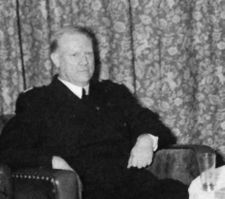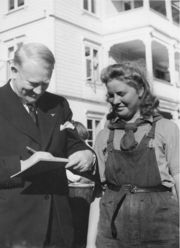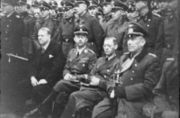Vidkun Quisling
| Vidkun Quisling | |
 |
|
|
Minister President of Norway
|
|
|---|---|
| In office February 1, 1942 – May 9, 1945 |
|
|
Minister of Defence
|
|
| In office 1931–1933 |
|
| Prime Minister | Peder Kolstad (1931–1932) Jens Hundseid (1932–1933) |
| Preceded by | Torgeir Anderssen-Rysst |
| Succeeded by | Jens Isak de Lange Kobro |
|
|
|
| Born | 18 July 1887 Fyresdal, Telemark, Norway |
| Died | 24 October 1945 (aged 58) Oslo, Norway |
| Political party | Agrarian Party (1933) Nasjonal Samling (1933–45) |
| Spouse(s) | Maria Vasilijevna Quisling |
Vidkun Abraham Lauritz Jonssøn Quisling (July 18, 1887 – October 24, 1945) was a Norwegian army officer and politician, who served as President of occupied Norway. He worked with Fridtjof Nansen during the famine in the Soviet Union, and served as Minister of Defence in the Bondepartiet government 1931–1933. In 1933 he founded the nationalist party Nasjonal Samling ("National Gathering"), and during World War II, from 1942 to 1945, he served as Minister-President of the collaborationist Norwegian government, after being appointed by the German authorities. After the war he was tried for high treason and executed by firing squad. Today in Norway and other parts of the world, "Quisling" is a synonym for "Traitor".
Contents |
Early life
Quisling was the son of a Church of Norway pastor and genealogist, Jon Lauritz Quisling, who preferred to be called "Qvisling", from Fyresdal. Other ancient names of the family were "Quislinus" or "Quislin". Both of his parents belonged to old and distinguished families of Telemark.
Quisling had a flair for mathematics, and in his early teens had sent in corrections to a national mathematical textbook. Impressed by the age of the boy, the editors made the corrections, and included his name and some adulation as encouragement for other young boys to pay attention to their mathematics. After WWII, editions kept the corrections and adulation, but changed all references to his name to en gutt ("a boy").
His early life was varied and successful; he became the country's best war-academy cadet upon graduation in 1911, and achieved the rank of major in the Norwegian Army. He worked with Fridtjof Nansen in the Soviet Union during the famine of the 1920s.[1] In 1923, he married Maria Vasilevna Pasechnikova (Russian: Мари́я Васи́льевна Па́сечникова), a native of Kharkov born in 1900 and known to her intimates as "Mara". For his services in looking after British interests after having broken diplomatic relations with the Bolshevik government, the United Kingdom in 1929 awarded him the CBE (which was later revoked by King George VI in 1940).[2] He later served as defense minister in the Agrarian governments from 1931 to 1933.[3]
Religion and metaphysical yearnings
As a child, Quisling was already interested in religion and metaphysics, and his ponderings upon this subject never abated. He went as far as expounding his own religion, called Universalism, an elaboration and development of sorts of Christianity. It is presented as an addendum in the book containing the extant diaries and letters of Maria Quisling.
The Nasjonal Samling Party
On 17 May 1933, Norwegian Constitution Day, Quisling and lawyer Johan Bernhard Hjort formed Nasjonal Samling ("National Unity"), the Norwegian fascist political party. Nasjonal Samling had an anti-democratic, Führerprinzip-based political structure, and Quisling was to be the party's Fører (Norwegian: "leader", equivalent of the German "Führer"). He was sometimes referred to as "the Hitler of Norway". The party went on to have modest successes: in the election of 1933, four months after it was formed, it garnered 27,850 votes (approximately 2%), following support from the Norwegian Farmers' Aid Association, with which Quisling had connections from his time as a member of the Agrarian government. However, as the party line changed from a religiously rooted one to a more pro-Nazi and anti-Semitic policy from 1935 on, church support waned, and in the 1936 elections the party received fewer votes than in 1933. The party became increasingly extremist, and party membership dwindled to an estimated 2,000 before the German invasion, but under the German occupation, by 1945, some 45,000 Norwegians had become members of the party.
German invasion and coup d'état
| Norway and World War II |
|---|
| Key events |
|
Weserübung |
| People |
|
Haakon VII of Norway |
|
Vidkun Quisling · Jonas Lie |
| Organizations |
|
Milorg · XU · Linge |
| Supported legitimate exiled government. |
| Supported German occupants and Nasjonal Samling party. |


On 9 April 1940, Germany invaded Norway by air and sea, intending to capture King Haakon VII and the government of Prime Minister Johan Nygaardsvold; however, alert to the invasion, Foreign Minister C.J. Hambro arranged their evacuation to Hamar.[4] The cruiser Blücher, which had been carrying most of the personnel intended to take over running Norway, was sunk by cannon fire and torpedoes from Oscarsborg festning (Oscarsborg Fortress) in Oslofjord. The Germans had expected the Government to surrender, and to have its replacement ready, but neither happened.
In the morning, two German embassy officials (Hans Wilhelm Scheidt and Richard Schreiber) visited Quisling to encourage him to form a government, and Quisling drew up a list of Ministers. In the afternoon he telephoned some coastal batteries urging them to cease resistance to German forces. At 7:32 PM, without waiting for recognition, Quisling burst into the NRK studios in Oslo and broadcast a proclamation naming himself Prime Minister and ordering all resistance to halt at once. In hindsight, this treasonous act doomed any chance of persuading Norway to surrender (as Denmark had the previous day).[5] It was claimed at the time that Quisling's seizure of power in a puppet government had been part of the German plan.[6]
The next day the German minister Curt Bräuer traveled to Elverum, Norway where the legitimate government had moved. He demanded that King Haakon appoint Quisling Prime Minister and return to Oslo. In an emotional meeting with the cabinet, King Haakon let it be known he would sooner abdicate than appoint any government headed by Quisling. By this time, the news of Quisling's treason had reached Elverum. The government unanimously voted to advise the king not to recognize Quisling and urged the people to continue to resist. With no popular support, Quisling was no longer of use to Hitler.
Later that same month he tried again to organize a government under Josef Terboven, who had been installed as Reichskommissar, reporting directly to Hitler. The relationship between Quisling and Terboven was tense, however, and Quisling was unable to find any prominent Norwegians willing to serve as ministers in his Cabinet.
On 25 September 1940 Gauleiter Terboven addressed the Norwegian people in a radio broadcast. Terboven said he had tried in vain to negotiate with the old parties and that the Quisling movement would be the only one tolerated in the future.[7][8]
Terboven, seeing an advantage in having a Norwegian in an apparent position of power, declared the monarchy to be "suspended"[9] and named Quisling to the post of Minister-President of the National Government in 1942, a position the self-appointed Fører assumed on 1 February.
Arrest and trial
Quisling stayed in power until he was arrested on 9 May 1945 at Møllergata 19 in Oslo. He lived in a mansion on Bygdøy in Oslo that he called "Gimle", after the place in Norse mythology where survivors of Ragnarok were to live. The house, now called Villa Grande, is a Holocaust museum.[10]
In the course of the treason trials, Quisling was convicted of high treason (September 10)[11] and, along with two other Nasjonal Samling leaders, Albert Viljam Hagelin and Ragnar Skancke, was sentenced to death. He was executed by firing squad at Akershus Fortress on 24 October 1945.[12] The charges were based on his coup d'état in April 1940, his revocation of the mobilization order, his encouragement of Norwegians to serve in the Norwegian SS division, his assistance in the deportation of Jews, his responsibility for the execution of Norwegian patriots and a number of other charges.
His widow Maria lived in Oslo until her death in 1980.[13] They had no children.[14]
'Quisling'
Today in many countries, "quisling" is synonymous with traitor, particularly one who collaborates with enemies. The term was coined by the British newspaper The Times in its leader of 15 April 1940, entitled "Quislings everywhere." The editorial asserted,
To writers, the word Quisling is a gift from the gods. If they had been ordered to invent a new word for traitor... they could hardly have hit upon a more brilliant combination of letters. Actually it contrives to suggest something at once slippery and tortuous.[15]
The noun has survived; for a while during and after the war, the back-formed verb "to quisle" (pronounced "quizzle") was used. One who was "quisling" was committing treason.[16]
Footnotes
- ↑ "Quisling Victory". Time Magazine. 30 October 1933. http://www.time.com/time/magazine/article/0,9171,754021,00.html. Retrieved 17 January 2009.
- ↑ "People". Time Magazine: p. 1. 24 June 1940. http://www.time.com/time/magazine/article/0,9171,764097,00.html. Retrieved 18 January 2009.
- ↑ "Tale of Two Brothers". Time Magazine: p. 2. 22 April 1940. http://www.time.com/time/magazine/article/0,9171,763850-2,00.html. Retrieved 18 January 2009.
- ↑ Paul M. Hayes, "Quisling" (David & Charles, Newton Abbot, 1971), p. 211.
- ↑ Paul M. Hayes, "Quisling" (David & Charles, Newton Abbot, 1971), p. 212–7.
- ↑ Current Biography 1940, pp 669–70
- ↑ Shirer, William L, "Berlin Diary", 1941, Hamish Hamilton, London,
- ↑ ""Commission State"". Time Magazine: p. 2. 7 October 1940. http://www.time.com/time/magazine/article/0,9171,802044-2,00.html. Retrieved 18 January 2009.
- ↑ Cahoon, Ben. "World Statesmen – Norway". Worldstatesmen.org. http://www.worldstatesmen.org/Norway.htm. Retrieved 2010-01-09.
- ↑ "Article: Norway turns traitor Quisling's home into symbol of tolerance - AP Worldstream | HighBeam Research - FREE trial". Highbeam.com. 2005-08-30. http://www.highbeam.com/doc/1P1-112640182.html. Retrieved 2010-01-09.
- ↑ nytimes
- ↑ "Justice—I". Time Magazine. 5 November 1945. http://www.time.com/time/magazine/article/0,9171,852394,00.html. Retrieved 18 January 2009.
- ↑ Yourieff, Alexandra Andreevna Voronine; Kirsten A. Seaver (2007). In Quisling's shadow: the memoirs of Vidkun Quisling's first wife, Alexandra. Hoover Institution Press. p. 457. ISBN 978-0817948320. http://books.google.com/books?id=kaiyKJZxjBUC&pg=PR12&lpg=PR12&dq=maria+quisling+oslo+died+1980&source=bl&ots=qa2rFAAx3J&sig=JEvV74qj7nA5rDah45IPy0hZAdA&hl=en&ei=Nz3dSoTYC4_usQPZ1N3iDw&sa=X&oi=book_result&ct=result&resnum=6&ved=0CBwQ6AEwBQ#v=onepage&q=1980&f=false. Retrieved 2009-10-19.
- ↑ Dahl, Hans Fredrik (1999). Quisling: A Study in Treachery. Cambridge University Press. p. 129. ISBN 978-0521496971. http://books.google.com/books?id=GaR-7WVcVjgC&pg=PA129&dq=maria+quisling+childless&ei=Qj_dSsuuMZX6lQSlvoX-Bw#v=snippet&q=childless&f=false. Retrieved 2009-10-19.
- ↑ "Quislers". Time Magazine: p. 1. 29 April 1940. http://www.time.com/time/magazine/article/0,9171,794977,00.html. Retrieved 18 January 2009.
- ↑ Current Biography 1940, p669
Further reading
In Norwegian
- Dahl, Hans Fredrik (1991) Quisling – En fører blir til, Oslo: Aschehoug, ISBN 82-03-15632-0 (BIBSYS)
- Dahl, Hans Fredrik (1992) Quisling – En fører for fall, Oslo: Aschehoug, ISBN 82-03-16960-0 (BIBSYS)
- Borgen, Per Otto (1999) Norges statsministre, Oslo: Aschehoug, ISBN 82-03-22389-3 (BIBSYS)
In English
- Høidal, Oddvar K. (1989) Quisling: A study in treason, Oslo: Norwegian University Press (Universitetsforlaget), ISBN 82-00-18400-5
- Dahl, Hans Fredrik (1999) "Quisling: A study in treachery", Stanton-Ife, A.-M. (transl.), Cambridge University Press, ISBN 0-521-49697-7
See also
- Operation Weserübung
- Norwegian campaign
- British campaign in Norway
- Norwegian resistance movement
| Political offices | ||
|---|---|---|
| Preceded by Torgeir Anderssen-Rysst |
Minister of Defence 1931–1933 |
Succeeded by Jens Isak de Lange Kobro |
| Preceded by Office created |
Minister President of Norway 1942–1945 |
Succeeded by Office abolished |
|
|||||||||||||||||||||||||||||||||||||||||||||||||||||||||||||||||||||||||||||||||||||||||||||||||||||||||||||||||||||||||||||||||||||